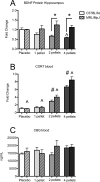Strain differences in the effects of chronic corticosterone exposure in the hippocampus
- PMID: 22735575
- PMCID: PMC3587173
- DOI: 10.1016/j.neuroscience.2012.06.017
Strain differences in the effects of chronic corticosterone exposure in the hippocampus
Abstract
Stress hormones are thought to be involved in the etiology of depression, in part, because animal models show they cause morphological damage to the brain, an effect that can be reversed by chronic antidepressant treatment. The current study examined two mouse strains selected for naturalistic variation of tissue regeneration after injury for resistance to the effects of chronic corticosterone (CORT) exposure on cell proliferation and neurotrophin mobilization. The wound healer MRL/MpJ and control C57BL/6J mice were implanted subcutaneously with pellets that released CORT for 7 days. MRL/MpJ mice were resistant to reductions of hippocampal cell proliferation by chronic exposure to CORT when compared to vulnerable C57BL/6J mice. Chronic CORT exposure also reduced protein levels of brain-derived neurotrophic factor (BDNF) in the hippocampus of C57BL/6J but not MRL/MpJ mice. CORT pellet exposure increased circulating levels of CORT in the plasma of both strains in a dose-dependent manner although MRL/MpJ mice may have larger changes from baseline. The strains did not differ in circulating levels of corticosterone binding globulin (CBG). There were also no strain differences in CORT levels in the hippocampus, nor did CORT exposure alter glucocorticoid receptor or mineralocorticoid receptor expression in a strain-dependent manner. Strain differences were found in the N-methyl-D-aspartate (NMDA) receptor, and BDNF I and IV promoters. Strain and CORT exposure interacted to alter tropomyosine-receptor-kinase B (TrkB) expression and this may be a potential mechanism protecting MRL/MpJ mice. In addition, differences in the inflammatory response of matrix metalloproteinases (MMPs) may also contribute to these strain differences in resistance to the deleterious effects of CORT to the brain.
Copyright © 2012. Published by Elsevier Ltd.
Figures





Similar articles
-
Enhanced sensitivity of the MRL/MpJ mouse to the neuroplastic and behavioral effects of chronic antidepressant treatments.Neuropsychopharmacology. 2009 Jun;34(7):1764-73. doi: 10.1038/npp.2008.234. Epub 2009 Jan 28. Neuropsychopharmacology. 2009. PMID: 19177066 Free PMC article.
-
Brain monoamines and antidepressant-like responses in MRL/MpJ versus C57BL/6J mice.Neuropharmacology. 2013 Apr;67:503-10. doi: 10.1016/j.neuropharm.2012.11.027. Epub 2012 Dec 6. Neuropharmacology. 2013. PMID: 23220293 Free PMC article.
-
Enhanced sensitivity of the MRL/MpJ mouse to the neuroplastic and behavioral effects of acute and chronic antidepressant treatments.Exp Clin Psychopharmacol. 2010 Feb;18(1):71-7. doi: 10.1037/a0017295. Exp Clin Psychopharmacol. 2010. PMID: 20158296 Free PMC article.
-
Determinants and significance of corticosterone regulation in the songbird brain.Gen Comp Endocrinol. 2016 Feb 1;227:136-42. doi: 10.1016/j.ygcen.2015.06.010. Epub 2015 Jun 30. Gen Comp Endocrinol. 2016. PMID: 26141145 Free PMC article. Review.
-
Regeneration of articular cartilage in healer and non-healer mice.Matrix Biol. 2014 Oct;39:50-5. doi: 10.1016/j.matbio.2014.08.011. Epub 2014 Aug 28. Matrix Biol. 2014. PMID: 25173437 Free PMC article. Review.
Cited by
-
A selective HDAC 1/2 inhibitor modulates chromatin and gene expression in brain and alters mouse behavior in two mood-related tests.PLoS One. 2013 Aug 14;8(8):e71323. doi: 10.1371/journal.pone.0071323. eCollection 2013. PLoS One. 2013. PMID: 23967191 Free PMC article.
-
Novel role for mineralocorticoid receptors in control of a neuronal phenotype.Mol Psychiatry. 2021 Jan;26(1):350-364. doi: 10.1038/s41380-019-0598-7. Epub 2019 Nov 19. Mol Psychiatry. 2021. PMID: 31745235 Free PMC article.
-
Differential Behavioral and Neurobiological Effects of Chronic Corticosterone Treatment in Adolescent and Adult Rats.Front Mol Neurosci. 2017 Feb 2;10:25. doi: 10.3389/fnmol.2017.00025. eCollection 2017. Front Mol Neurosci. 2017. PMID: 28210212 Free PMC article.
-
Efficacy and safety of antenatal steroids.Am J Physiol Regul Integr Comp Physiol. 2018 Oct 1;315(4):R825-R839. doi: 10.1152/ajpregu.00193.2017. Epub 2018 Apr 11. Am J Physiol Regul Integr Comp Physiol. 2018. PMID: 29641233 Free PMC article. Review.
-
Reduced brain somatostatin in mood disorders: a common pathophysiological substrate and drug target?Front Pharmacol. 2013 Sep 9;4:110. doi: 10.3389/fphar.2013.00110. Front Pharmacol. 2013. PMID: 24058344 Free PMC article. Review.
References
-
- Balu DT, Hodes GE, Hill TE, Ho N, Rahman Z, Bender CN, Ring RH, Dwyer JM, Rosenzweig-Lipson S, Hughes ZA, Schechter LE, Lucki I. Flow cytometric analysis of BrdU incorporation as a high-throughput method for measuring adult neurogenesis in the mouse. J Pharmacol Toxicol Methods. 2009b;59:100–107. - PMC - PubMed
-
- Benekareddy M, Mehrotra P, Kulkarni VA, Ramakrishnan P, Dias BG, Vaidya VA. Antidepressant treatments regulate matrix metalloproteinases-2 and -9 (MMP-2/MMP-9) and tissue inhibitors of the metalloproteinases (TIMPS 1-4) in the adult rat hippocampus. Synapse. 2008;62:590–600. - PubMed
Publication types
MeSH terms
Substances
Grants and funding
LinkOut - more resources
Full Text Sources
Molecular Biology Databases
Research Materials
Miscellaneous

